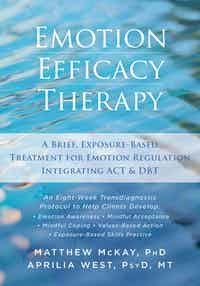Part two of a four-part series on emotion efficacy therapy.
Read part one here.
By Matthew McKay, PhD, and Aprilia West, PsyD
When clients are beset by strong emotions, they often react in ways that only serve to intensify and prolong their affects. These maladaptive responses may include trying to suppress the emotion, acting on the emotion urge (emotion-driven behavior), and/or ruminating—all of which keep clients stuck at the top of an emotion wave.
“Emotion surfing” is a form of emotion exposure therapy that helps clients learn to apply mindful acceptance when they are emotionally triggered. By practicing emotion surfing, clients observe and accept all parts of their emotional experience, instead of reacting to it, or trying to control or change it. Helping clients learn to turn towards their pain through emotion surfing promotes mindful acceptance—the ability to observe and accept all parts of their emotion: sensations, thoughts, feelings, and urges. Often, clients learn they can tolerate the distress, and in most cases, their distress decreases as they stay with the experience.
Explain to clients that: (1) emotions always come in waves; (2) emotion waves are usually short lived through emotion surfing; and (3) “surfing” helps stop doing things that make emotions worse: emotion suppression, ruminating, and engaging in emotion-driven behavior.
You can guide clients through the surfing process whenever a strong affect shows up in session. Here’s a brief script you can use to have the dialogue with your client:
-
What do you notice in your body right now? Can you describe the sensation?
-
What are the feelings that go with that?
-
What are your thoughts? Can you just notice them and let them go?
-
Where are you on the wave? How strong is the emotion? (Use the 0-10 Subjective Units of Distress Scale—SUDS)
-
Do you have any urges? What does the emotion make you want to do? See what it’s like to notice the urge without acting on it.
Now return again to the physical sensations and the emotion—have clients describe them. Continue through the steps of the process several more times.
Your demeanor should be one of curiosity, and encourage curiosity on the part of the client. Ask what was learned at the end of each emotion-surfing session. Many clients report feeling less afraid or overwhelmed by their emotions. Some are surprised to see how thoughts fuel affect, and that emotion surfing limits rumination. Some clients describe seeing a moment of choice, where they can decide not to act on an emotion.
The more you encourage clients to emotion surf, the more they’ll report improved emotion acceptance and distress tolerance.
Matthew McKay, PhD, is a professor at the Wright Institute in Berkeley, CA. He has authored and coauthored numerous books, including The Relaxation and Stress Reduction Workbook, Self-Esteem, Thoughts and Feelings, When Anger Hurts, and ACT on Life Not on Anger.
Aprilia West, PsyD, MT, is a psychotherapist and emotion researcher based in the San Francisco Bay Area, where she specializes in treating anxiety disorders, mood disorders, and trauma.


 2024 Peace Playbook: 3 Tactics to Avoid Clashes with Your Partner
2024 Peace Playbook: 3 Tactics to Avoid Clashes with Your Partner